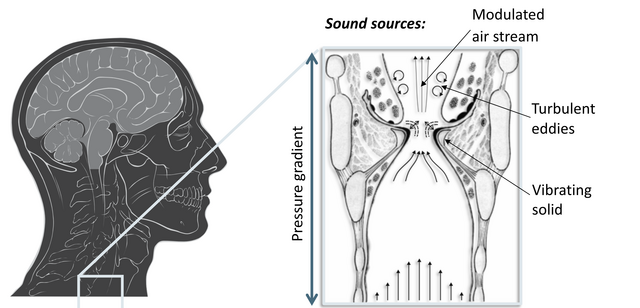Mucosal waves on vocal folds in voice production

Today, communication disorders are of high social and economic relevance. Depending on the study, for teachers between 11% and 63% were reported to have voice problems, compared to around 6% within the normal population. This project will bring together highly experienced research teams from Czechia, Germany and Austria to expand the knowledge on the nature of the mucosal wave which is important for more insightful diagnosis of voice disorders.
Voice production forms the basis of human communication, and voice disorders can have a negative impact on quality of life. The mechanism of voice production is highly complex and multi-physical; however, many of its underlying biomechanical aspects remain unclear. It involves interactions between airflow, self-sustained vocal fold oscillations and acoustics. Vocal fold oscillations are excited by airflow. For ordinary voicing, the vibration amplitudes are typically restricted by contact, i.e. complete closure of the glottis. In good-quality voice production, the vocal folds oscillate in such a way that the superficial tissue layer of the vocal folds moves in a wave-like motion, creating the mucosal wave. Mucosal waves are recognised as playing a crucial role in healthy voice production. In medicine, the visual identification of mucosal waves has been incorporated into standard clinical evaluation protocols for diagnosing voice disorders via laryngoscopy. However, visual evaluations of mucosal waves in clinical practice have been rather unreliable due to their non-uniform appearance in laryngoscopic images and incomplete understanding of mucosal wave properties. The aim of this project is to identify, describe and specify the conditions that lead to mucosal waves appearing on vibrating vocal folds. Such knowledge is important for the following reasons: (1) more insightful diagnosis of voice disorders, (2) the design and optimisation of artificial vocal fold replacements, and (3) improving the accuracy of mathematical and physical models of voice production. Our plans include improving experimental models of human phonation and developing and testing highly sophisticated mathematical models and methods suitable for capturing the complex process of human phonation.
The teams involved are: (1) Czech Technical University in Prague, Faculty of Mechanical Engineering, led by Petr Svacek; (2) Palacky University, Faculty of Sciences, Dept. Experimental Physics, Voice Research Lab., led by Jan Švec; (3) Institute of Thermomechanics of the Czech Academy of Sciences led by Jaromír Horáček; (4) Friedrich-Alexander-University Erlangen-Nürnberg, University Hospital Erlangen, Medical School; Laboratory for Computational Medicine, led by Michael Döllinger; (5) Graz University of Technology, Institute of Fundamentals and Theory in Electrical Engineering, led by Manfred Kaltenbacher.
The research project is funded by Czech Science Foundation (GACR), Österreichischer Wissenschaftsfond(FWF) and Deutsche Forschungsgemeinschaft (DFG).
Manfred Kaltenbacher
Tel.: +43 316 873 - 7250
Email
